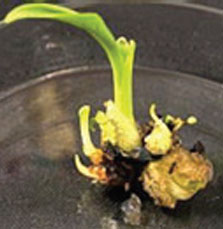In vitro Selection of Water-Deficit Tolerant Callus of Banana cv. ‘Kluai Hom Tong’
Keywords:
banana, Kluai Hom Tong, water-deficit tolerant, in vitroAbstract
The objective of this research was to select callus of banana ‘Kluai Hom Tong’ tolerated to water deficit by using polyethylene glycol (PEG) 6000 as a selective agent in aseptic conditions. The results showed that the MS medium containing 5 mg/L BA was suitable for inducing the highest number of shoots and initiated callus at the base of shoots. The 0.5 cm calli were cultured on MS medium containing 5 mg/L BA and 0 (control) 5, 10, 15 and 20% (w/v) of PEG for 2 months. It was found that MS medium containing BA 5 mg/L without PEG had an average shoot number of 5.1. Number of shoots derived from callus were decreased when they were cultured on MS media containing 5 -15% PEG. The color of the calli changed to black color and the lethal percentage was 50-60% in MS medium with 10 -15% PEG, while all calli changed to black at the level of 20% PEG . After calli were further cultured in the same media for one more month, the lethal percentage was increased. Then, all of the PEG-treated calli were transferred into MS medium containing 5 mg/L BA without PEG. The results showed that the new buds were induced from the survival callus derived from the media with 5-15% PEG, while none of the calli from 20% PEG developed into plantlet. In conclusion, the use of PEG at the level of 10-15% had a tendency to select the water-deficit tolerant callus of banana ‘Kluai Hom Tong’ at the laboratory level
References
กรมการค้าภายใน กระทรวงพาณิชย์.2562.สถานการณ์ปัจจุบันกล้วยหอมทอง ประจำสัปดาห์ที่1 เดือนพฤษภาคม 2562. (ระบบออนไลน์). แหล่งข้อมูล: www.kbp.ops.moc.go.th/ewt_dl_link.php?nid=1874 (13 กุมภาพันธ์ 2563)
พิชญา ดิลกพัฒนมงคล.2553 ตอบปัญหาเรื่องยาโดยเภสัชกรหน่วยคลังข้อมูลยา.(ระบบออนไลน์).แหล่งข้อมูล: www.phamacy.mahidol.ac.th/dic (17 กุมภาพันธ์ 2563)
รงรอง หอมหวล, เรวัติ เลิศฤทัยโยธิน รัตนา เอการัมย์ และ ชัยณรงค์ รัตนกรีฑากุล. 2553 การคัดเลือกแคลลัสอ้อยทนแล้งโดยใช้สาร Polyethylene glycol ในสภาพปลอดเชื้อ. การประชุมทางวิชาการ มหาวิทยาลัยเกษตรศาสตร์ ครั้งที่ 7 น. 1681-1688.
Adkins, S.W., R. Kunanuvatchaidach and I.D. hGodwin.1995. Somaclonal variation in rice: Drought tolerance and other agronomic characters. Australian J. Bot..43: 201-209.
Cano, E.A., A. Perez., V. Moreno, M. Caro and M. Bolarin.1998. Evaluation of salt tolerance in cultivated and wild tomatospecies through in vitro shoot apex culture. Plant Cell Tiss. and Organ Cult. 53(1): 19-26.
Errabii T, C.. B. Gandonou, H. Essalmani, J. Abrini, M. Idaomar and N. Skali-Senhaji. 2006. Growth, proline and ion accumulation in sugarcane callus cultures under drought-induced osmotic stress and its subsequent relief. African J. Biotechnol. 5: 1488-1493.
Mahmound. R. A., O.S. Hassan, A. Abou-Hashish and A. Aminin. 2017. Role of trehalose during recovery from drought stress in micropropagated banana (Musa spp.) transplants. RJPBCS.8(2): 1339-1345.
Murashige. T and F. Skoog. 1962. A revised medium for rapid growth and bioassays with tobacco cultures. Physiol.Plant.15: 473-497.
Saeedavi. L., A. Soleimani and M.E. Amiri. 2017. Improvement of shoot-tip culture proliferation in banana using PEG6000. Iranian J.Plant Physiol. 7(3): 2105-2111.
Turner, D.W., J.A. Forstescue and D.S. Thomas. 2007. Environmental physiology of the bananas (Musa spp.) Braz. J. Plant Physiol. 19(4): 463-484.
Wagih, M.E., A. Ala and Y. Musa. 2004. Regeneration and evaluation of sugarcane somaclonal variants for drought tolerance. Soc. Sugar Res. Promot. 6(1&2): 35-40.






